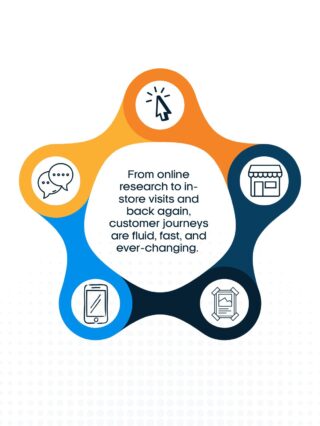Further supporting recent data in the evolution of search trends, TikTok recently announced the launch of TikTok Search Ads Campaigns, giving advertisers another strategy to target younger demographics where they are searching. User behavior on social media platforms is rapidly changing, especially among Gen Z, who are shifting their search behavior from only using traditional search engines to increasingly turning to social media for answers and recommendations.
The Emergence of Social Media as a Search Tool
Meta reports that 60% of time on Facebook and Instagram is now being spent on video1, with an increasing focus on shareable content as a metric for success. The takeaway? Users are using these social platforms as a place to discover things to tell friends about.2
The news from TikTok is unsurprising, considering that over 60% of Gen Z has used the platform as a search engine, according to a January 2024 Adobe study. 3 What might come as a surprise, however, is that this shift in search behavior isn’t as recent as many think. Research shows that Gen Z’s search habits began changing significantly as early as 20174—well before TikTok’s surge in U.S. downloads in 2020 and beyond.
With the launch of TikTok Search Ads Campaigns, advertisers can target the search results page, with a keyword-based solution that enables brands to appear in search results. This allows advertisers to have full control on how their content appears in the results, and target users who are actively exploring.5
Human-Centric and Opinion-Driven Landscape
The shifting of consumer search behavior by Gen Z alludes to the fact that they are interested in more immersive and visual forms of search and discovery. Specifically, Gen Z turns to social media for everything from beauty recommendations to career advice. With social media, users can view the ins and outs of restaurants and watch tutorials as opposed to text-based results from traditional search engines. Certainly, Google’s shift away from ranking blogs and other user-experience-rich sites in recent years has not been in favor of this shift.
Younger shoppers also expect brands to come to them with personalized recommendations, as dictated by social algorithms. In addition, Gen Z craves human connection in their online presence, shifting the shopping journey to a human-centric and opinion-driven landscape. Gen Z brand discovery via social increased by 36% while brand discovery via search decreased by 15% from 2018 to 2023.6
Shoppable Social Platforms
Social platforms have become more shoppable, allowing consumers to stay within one platform for connecting with friends, searching for recommendations, and shopping for their favorite brands and products. TikTok Shop rolled out to the U.S. in 2023, while Meta recently came to an agreement with Amazon that allows users to buy products from the retailer within Facebook and Instagram.

TikTok Shop

Shop With Google Instagram Ad
Traditional Search Isn’t Going Away
Google is still top of mind for other generations, with 79% of adults aged 55-64, 76% of those aged 35-44, and 74% of those aged 45-54 using Google Search.7 Taking note of Gen Z’s search habits, Google has taken steps to make the search experience more visual.
Fear not, social search advertising is not taking away traditional search budgets just yet due to the limitations of some platforms that don’t allow keyword targeting or standalone search ads. Categories like beauty and food may return more favorable search results on social, while categories like home and auto will remain popular searches across traditional search.
Advertiser Strategies
Understanding the shift in behavior, it’s no surprise that social platforms are adapting alongside consumers, introducing ads in search results. These formats surface relevant ads alongside organic search results when advertisers opt into it.
Advertisers should focus on search engine optimization (SEO), optimizing content for more visibility, in social media app’s search results pages. Keywords from details like captions, sounds, and hashtags may be used by algorithms in ranking content. After all, the call-and-response of search functions inside social apps are mini search engines in their own right.
While TikTok may be banned from the U.S. as of early next year, it’s important to keep an eye on user behavior as usage won’t just go away; it’ll shift elsewhere. With that, it’s important for advertisers to have a presence on multiple social platforms and channels to account for the wide range of demographics and behaviors within a target market; especially when winning market share among younger consumers.
Interested in learning more about this topic? Contact our search experts today to connect!
Sources
1. Meta Q1 2024 Earnings Update
2. https://www.searchenginejournal.com/instagram-algorithm-shift-why-sends-matter-more-than-ever/521389/
3. https://www.socialmediatoday.com/news/tiktoks-rise-discovery-platform-infographic/719066/
4. https://www.emarketer.com/content/gen-z-social-search-habits
5. https://techcrunch.com/2024/09/24/tiktok-comes-for-googles-ad-business-as-it-starts-letting-advertisers-target-its-search-results-page/
6. https://www.business.reddit.com/blog/cannes-from-the-couch-shopping-takeaways
7. https://www.forbes.com/sites/johnkoetsier/2024/03/11/genz-dumping-google-for-tiktok-instagram-as-social-search-wins/
Contributors: Kristie Murphy, Geoff Schopp




